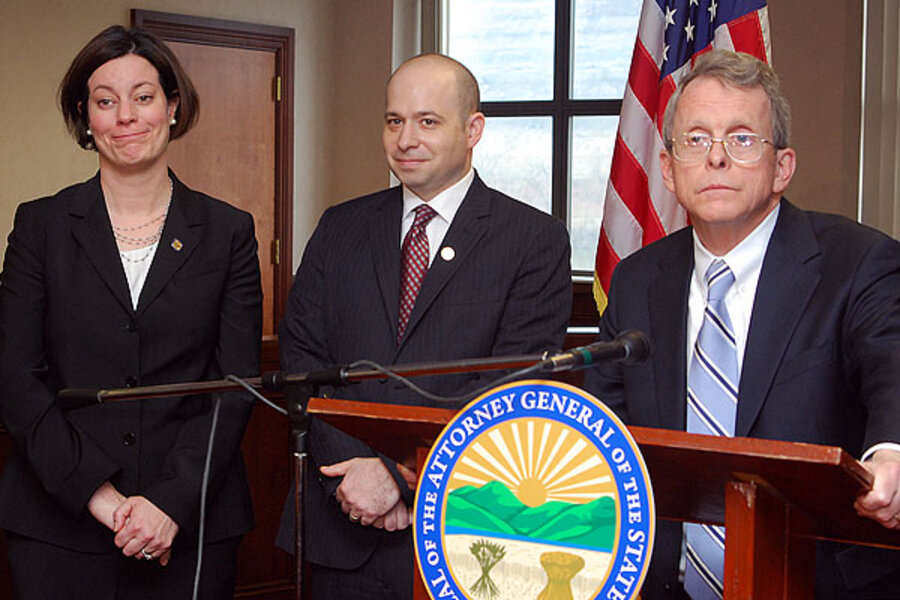Steubenville's troubling question: Is rape just a part of 'hook-up culture'?
Loading...
| Chicago
The rape of a teenage girl at a series of parties in Steubenville, Ohio, last August – and the vindictive attacks against her on social media that followed – are raising troubling questions about whether too many of today’s youth are so desensitized to sex and sexual imagery that rape is becoming an accepted part of a “hook-up culture.”
On Sunday, two high school football players were found guilty of rape and disseminating a nude photo of a minor. Both could remain in juvenile detention until they turn 21. The next day, two Steubenville girls were arrested for threatening the victim over Twitter.
But Ohio Attorney General Mike DeWine is pressing further, saying that the case is emblematic of a wider cultural problem. Earlier this week, he announced he was convening a grand jury in April to investigate whether additional charges should be filed in the case. And on Wednesday, he announced an initiative to ensure that every Ohio county offers comprehensive services for rape victims.
“There seems to be an unbelievable casualness about rape and about sex. It is a cavalier attitude – a belief that somehow there isn’t anything wrong with all of this. Rape is not a recreational activity,” said Mr. DeWine. “We, as a society, have an obligation to do more to educate our young people about rape. They need to know it is a horrible crime of violence. And it is simply not OK.”
Only 36 Ohio counties have rape-crisis services, such as a 24-hour hotline, criminal justice and hospital advocacy, or community outreach, he said. His goal is to have all 88 counties have minimum standard services within five years.
Testimony in the Steubenville case suggested that many of the young people involved or present during the rape did not know the definition of rape, and were not prepared – or did not even know how – to alert authorities. DeWine says at least 16 teenagers at the party still refuse to cooperate with authorities.
Those attitudes are the result of many factors, activists and academics say.
For one, school sex-education programs typically focus only on abstinence or birth control, not issues like bystander intervention or violence prevention, which can help young people identify rape and avoid automatically blaming the victim. Steubenville highlights the need to open a more honest and comprehensive conversation among young people about rape, some say.
“Much of [rape prevention] comes down to what’s taught in schools or not. If we focus only on preventing unintended pregnancies or reducing HIV, we’re not necessarily getting to a place where we can talk about healthy relationships,” says Abby Rosenstein of Advocates for Youth, an advocacy group in Washington that is calling for national sex-education standards that include discussion of rape prevention.
[Editor's note: The original version of this story misspelled Ms. Rosenstein's name.]
That conversation often starts with learning to not blame the victim. That played out in Steubenville, where people started disparaging the victim on social media – something that prosecutors say is still going on today.
“In cases where the victim knows her assailant and engages in any behavior that those in power deem as ‘provoking the assault,’ such as dressing or acting provocatively or drinking excessively, the case is less likely to be taken seriously and, if prosecuted, is less likely to result in a conviction,” says Kathleen Bogle, a sociologist at La Salle University in Philadelphia and author of “Hooking Up: Sex, Dating, and Relationships on Campus.”
According to the Ohio Domestic Violence Network, 90 percent of acquaintance rapes involve alcohol. Drinking while driving became stigmatized through public education efforts sustained over a long period of time. Ms. Bogle says that the same effort needs to be directed at the link between alcohol and sexual violence, because many young people are prone to believe that consent is assumed and that the victim invited the assault because she was drinking.
“The hook-up culture is linked to drinking and it’s a really awkward thing to teach about, especially on college campuses and high schools where kids are not supposed to be drinking at all. The finer points of how to drink and have sex responsibly is not exactly a topic that educators are willing to take on,” she says.
A deeper issue, however, could be shifting attitudes toward sex. For many youths, sex no longer carries the expectation of dating or a deeper relationship, as it did decades ago. Hypersexualized videos, films, and television shows portray sex as “anonymous, impersonal, and undertaken without commitment,” says Charles Camosy, assistant professor of Christian Ethics at Fordham University in New York City.
[Editor's note: The original version of this story misspelled Mr. Camosy's name.]
“The kind of sexual encounter presumed by our hook-up culture is virtually indistinguishable from a scene in a porn movie” and “its default expectation is that both people will mutually use each other’s bodies for pleasure” no matter the consequences, he adds.
Without some forum for discussing these societal images and counteracting their influence, teens’ sense of right and wrong can be obscured.
“Students should have the opportunity to have conversations about media literacy and the understanding that what we see in the media is not always a great reflection of consent,” says Ms. Rosenstein of Advocates for Youth.
Katie Hanna, executive director of the Ohio Alliance to End Sexual Violence, was present in the courtroom, says that the failure of bystanders to know what the right response was – and how to act – defined the Steubenville tragedy. “It was pretty clear people who saw what happened knew something was wrong but didn’t do anything.”







